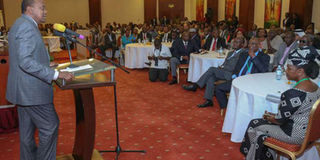Uhuru and Museveni strike deal on route for Sh400bn oil pipeline

President Uhuru Kenyatta addressing the business community during a Kenya-Uganda Business Forum at Serena hotel, Uganda. PHOTO | PSCU
What you need to know:
- National Treasury Cabinet Secretary Henry Rotich said financial advisers will help both countries to settle on a funding option with considerations of upstream oil firms and private investors with the governments’ help.
- Key decisions on the project, such as selecting the firm that did the design for the pipeline (Toyota Tsusho) were made at one of the Northern Corridor Integration summits.
- President Museveni affirmed the decision on the oil pipeline route, adding that Kenya had been instrumental in making key decisions that have changed the way business is done in the East African region.
Kenya and Uganda have settled on the northern route for the Sh400 billion crude oil pipeline that will transport oil from Albertine to Lokichar in Turkana County.
The agreement was made during President Uhuru Kenyatta’s state visit to Uganda, where he signed several bilateral agreements with President Yoweri Museveni.
President Kenyatta’s spokesman, Mr Manoah Esipisu, said the two leaders agreed that “subject to financing, security guarantees by Kenya, the Hoima-Lokichar-Lamu oil pipeline starts as soon as possible.”
“We are going to build pipelines for crude oil and refined petroleum products, as well as to join you, alongside our other East African partners, in the development of an oil refinery here in Uganda whose impact will be regional,” Mr Kenyatta said when he addressed the Ugandan parliament yesterday.
Speaking by phone from Kampala, Kenya’s petroleum legal adviser for the Energy Cabinet secretary, Mr Daniel Kiptoo, said: “We will give a clear update detailing financing of the pipeline, tendering for the construction firm and when construction will commence.”
UPSTREAM OIL FIRMS
National Treasury Cabinet Secretary Henry Rotich said financial advisers will help both countries to settle on a funding option with considerations of upstream oil firms and private investors with the governments’ help.
The decision brings to an end a debate that has seen Kenya and Uganda hold meetings since last year. The only other option for the pipeline was the southern route through Nairobi from Uganda to Mombasa.
Though oil investors prefer the southern route, citing security concerns on the northern route, the risks involved are higher. Taking the route involves displacing hundreds of residents, which would increase the project’s costs.
Presidents Kenyatta and Museveni have always considered construction of the oil pipeline an important component of the Northern Corridor Integration project.
Key decisions on the project, such as selecting the firm that did the design for the pipeline (Toyota Tsusho) were made at one of the Northern Corridor Integration summits.
“It is in the East African Community where this great African dream is becoming realised most concretely. It is the fastest integrating region in Africa, and one of the fastest growing in the world,” Mr Kenyatta said in his speech yesterday to Uganda’s Parliament.
“Kenya and Uganda, as each other’s leading trade and investment partners, are at the heart of this integration. Our Northern Corridor Integration projects have led the way.”
KEY DECISIONS
President Museveni affirmed the decision on the oil pipeline route, adding that Kenya had been instrumental in making key decisions that have changed the way business is done in the East African region.
“The movement of goods from Mombasa to Uganda takes three days, down from 18 days lately because of Kenya’s decision to embrace the Electronic Single Window System,” said Mr Museveni.
He added that together, EAC member countries will position the region as a leading global choice for investment because of the determination to forge a single, uninterrupted market governed by conducive business rules.
It is still unclear how the costs of building the pipeline will be shared between the two countries and what financing approach will be taken. Kenya has always insisted on the northern route, which is considered economically viable, bringing down the heavy costs involved in the project.
The World Bank last year pledged Sh54 billion for the crude oil pipeline, but the amount is considered too little given the overall cost of the project, which stands at Sh404.8 billion ($4 billion).
Uganda initially wanted the Hoima-Eldoret-Lamu/Mombasa route, arguing that it increases the value of its resources. Further, Uganda argued that the northern route added an extra 900 kilometres.
APPROPRIATE ROUTE
Two months ago, the two governments ordered respective energy ministries to come up with a cost-effective route for the pipeline.
This came after a contract with Japanese firm Toyota Tsusho to conduct a feasibility study that would advise on the appropriate route for the crude oil.
Several firms had shown interest in the route tender: Tullow Oil/Africa Oil submitted a design for the Lokichar-Lamu route; Toyota Tsusho (Hoima-Manda Bay, Lamu); Tullow/Total/CNOOC (Hoima-Lokichar-Lamu); Lapsset (Juba-Lokichar-Moyale-Lamu); and Total (Hoima-Eldoret-Lamu/Mombasa).
The 1,380-kilometre pipeline will take about three years to build, just in time for Tullow’s projected start in oil production in 2020.
The pipeline will serve Kenya, Uganda and South Sudan when complete. Ethiopia, where oil exploration activity has recently increased, could eventually benefit from the pipeline.





